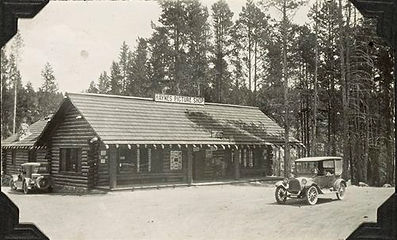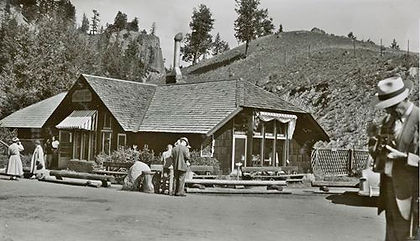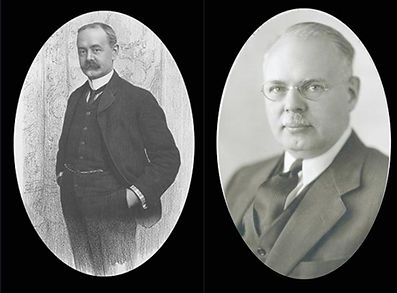

Yellowstone Storekeepers - Haynes Photo Shops
Copyright 2020 by Robert V. Goss. All rights reserved. No part of this work may be reproduced or utilized in any form by any means, electronic or mechanical, including photocopying, recording or by an information storage and retrieval system without permission in writing from the author.

Frank Haynes and the Haynes Photo Shops - 1884 to 1967
Frank Haynes discovers Yellowstone . . . .
Frank Jay Haynes was known as the "Official Park Photographer" for many years in Yellowstone. He was the parks' most famous photographer and he and his family operated the Haynes Photo Shops for 83 years. He was born in Michigan in 1853 and opened his first photo studio in Moorhead, Minnesota in 1876. He later moved to Fargo, ND and eventually to St. Paul Minnesota, where he maintained a studio for many years. The Northern Pacific RR employed him in 1875 to take promotional pictures along their new route from Minnesota to the West Coast. During these tours he discovered Yellowstone Park on a visit in 1881 with park superintendent Philetus Norris. He returned in ensuing years on photographic jaunts, and was appointed Official Photographer of the Yellowstone Park Improvement Co. He opened up his first photo studio at Mammoth in 1884. Thus began his memorable career in Wonderland.


Left: the Haynes Photo Shop at Mammoth Hot Springs, ca1890.
Right: Business card for "F. Jay Haynes & Bro." in St. Paul, Minn., ca1883. His "Bro" was Fred E. Haynes, official photographer for the St. Paul, Minneapolis, and Manitoba Railway Co.



Top Left: The Haynes Photo Shop at Mammoth Hot Springs, 1898, after addition at right new paint job. Note the antler fence. [Courtesy Montana Historical Society.]
Top Right: Haynes rented studio space in the lobby of the National Hotel at Mammoth in 1886. [YNP #14325]
Palace Car Studio
Haynes bought a railroad car from the Northern Pacific RR in 1885, and had it outfitted as a traveling photographic studio, complete with darkroom. NPRR hauled the car over their lines from Minnesota to the West Coast so that Haynes could take pictures of the towns and countryside for promotional purposes. He named it the Haynes Palace Car and operated it until 1905 when he sold it back to the railroad.
The Haynes Guidebook
In 1890 Haynes began publishing the 'Haynes Guidebook', an authoritative manual describing the many wonders of the park. Included were mile-by-mile travel logs, maps, information about camping, animals, geology, history, roads and, of course, the hot springs and geysers. These books, which were produced almost every year until 1967, were profusely illustrated. The year 1900 began the era of 'picture post cards' in Yellowstone when Frank, also known as F. Jay, began issuing postcards of Yellowstone. These cards became very popular with the tourists and hundreds of thousands of them were produced over the years.
Haynes' Harley-Davidson Motorcycle Deliveries . . .
In 1929, Jack Haynes arrived at the Montana Cycle and Supply motorcycle dealer in Billings to buy five new Harley-Davidsons with sidecars. Haynes wanted drivers of the olive drab painted motorcycles, equipped with sidecars, to pick up tourists’ film and race it to his processing lab where the film would be developed and printed overnight. The next morning the riders would carry printed photographs back to Haynes’ other Photo Shops so tourists could have their photographs the next day, a quick turnaround in 1929.
The Harleys purchased were the JDH model, “which could hit 85 mph and get 80 miles to the gallon. The motorcycle had a 74 cubic inch V-twin engine and sold for less than $400. That price is equivalent to almost $6,000 today.” He hired 4-5 drivers, had them trained, and they were off. The timing of purchase and service was unfortunate, as the Great Depression soon hit the country. But J.E. Haynes struggled through the economic crisis successfully. Over the ensuing years, more of his photo shops were equipped with photo processing plants and the unique Harley service was no longer needed. [Info from the Billings Gazette, 7July2019, retrieved online 20July2020]



Top Left: Interior of the Haynes Palace Car, a photography studio that rode the rails.
See the Car exterior at top of page.
Top Right: Cover of a Haynes Guide, 1927.
Author's Collection
Bottom Left: One of the five Harley Motorcycles purchased by Jack Haynes in 1929.
Photo by Don Devore, Billings Gazette, 7Jul2019
The Haynes Store Elk Fence
From the Salt Lake Tribune, Jan. 10, 1897
A FENCE OF ELKHORNS - MOST PICTURESQUE AND ONLY ONE EVER BUILT
Three Hundred Antlers Used - Three Hundred More Needed to Complete It - Located in Yellowstone Park
More than Three hundred elks have unwillingly contributed their magnificent antlers to beautify the inclosure [sic] around the studio of F. Jay Haynes, at Mammoth Hot Springs, in Yellowstone park. It is believed to be the only fence made of elk horns in the world. Mr. Haynes, with three of his men, collected and carefully selected these trophies; they all have twelve points, and many have the royal fourteen. From twenty to twenty-five thousand elk winter in Yellowstone park, and the greater percentage of these are males. About the 1st of April is shedding time, and it is easy enough to gather the shed horns, if one but ascertains the whereabouts of the animals at that time . . . . No one is allowed to remove these specimens from the park, as it is a National reservation, unless permission be granted by the superintendent. Mr. Haynes obtained a permit for the collection used for his fence with the proviso that they are to be kept in the park. Although there are now three hundred horns in this unique fence, as many more have to be added to complete it around the enclosure
Early expansion of the business . . . .
In 1897, F.J. Haynes built a log cabin studio across from the front of the Henry Klamer general store. That studio was used until 1930 when it was abandoned and later moved to another location where it was converted into a photo-finishing plant. A new photo shop was erected in 1927 at the tourist cabin area between the Hamilton Upper Store and Old Faithful Geyser. It was moved in 1974 to a spot near the old Snow Lodge (in front of what would later become the new Snow Lodge.) The Photo Shop in front of the new Snow Lodge was later moved, renovated and relocated to a spot between the new visitor center and OF Lodge for use as a museum for the Yellowstone Park Foundation.
At Old Faithful, Jack Ellis Haynes constructed a working model of Old Faithful Geyser in 1916 that erupted hot water to a height of 3 feet every 3-4 minutes. Reportedly six other units were built and sent to the Northern Pacific RR and other places for advertising purposes. A few years later a siren was installed at the shop that announced the impending eruption of the real Geyser.



Top Left: The Haynes Photo Shop at Old Faithful, across from the Klamer General Store, 1913. It measured 50'x24' and was expanded in 1911 and remodeled in 1923,
Top Right: Diagram for Old Faithful Jr. mechanical geyser built by Jack Haynes for display at his studio.
From 1916 Haynes Guide.
Left: Albumen print of the Old Faithful studio, ca1890s.
Bottom Left: OF photo shop, located in the tourist cabins area, 1951. It was moved in 1974 - see photo to right.
Bottom Right: Fires of 1988 threaten the entire Old Faithful village. A few cabins were burned at the rear, but luckily no significant buildings burned. When the new Snow Lodge was constructed in 1997-98, the old Snow Lodge was razed and the back section of the photo shop removed.


Changes at Mammoth . . . .
F.J. Haynes opened up his first photo studio at Mammoth in 1884 and in 1896 leased space for a small studio in the lobby of the National Hotel. In 1903 he moved his Mammoth Photo Shop to the base of Capitol Hill where an addition was built in 1910. A new facility was erected in 1920, and enlarged in 1923. A new photo shop studio and office were built in 1927-28 at the base of Capitol Hill. The original house/studio, along with the elk horn fence were torn down. A garage and darkroom were added in 1929. The old shop of 1920 was converted into a residence (currently used as Xanterra management residence


Top Left: The Haynes Picture Shop at Mammoth in 1920. This new building replaced the 1884 shop built across from the National Hotel. The structure is currently used as housing for Xanterra Parks & Resorts management personnel. J.E. Haynes Postcard #20118
Top Right: Haynes Photo Shop at Mammoth. This building replaced the earlier store at Mammoth and opened in 1929. The old shop nearby, was converted into a residence. Haynes Postcard #34059
Bottom Left: Picture shop at the Mammoth Auto Camp. It was established in 1927 and remodeled in 1934. Haynes Guide, 1936
Bottom Right: The Picture shop was at the far left of the large Cafeteria building, which was run by Pryor & Trischman at that time. 1939, YNP #185327-414


The Picture Shops at the Grand Canyon of the Yellowstone


Top Left: Picture Shop at Canyon Auto Camo, Haynes Guide 1922.
Top Right: Interior of 1922 Picture Shop. Haynes Guide 1922
Middle: 1924 Picture Shop relocated to near the Brink of the Falls. Haynes Guide 1924

In 1895, Frank Haynes opened a small studio inside of the 2nd Canyon Hotel. It presumably closed when the new hotel opened in 1911. F. J. Haynes secured a lease for one acre of land in 1914 at or near the Grand Canyon for building a picture shop, but this lease was apparently never used. A picture shop was established in 1917 in a small government building at Canyon until the building collapsed under heavy snow in early spring 1922. A new store opened that June at the auto camp.
A new store was built in 1924 on the site of the old log Soldier Station, closer to the Brink of the Falls. The store was remodeled and a photo-finishing lab added in 1929. A temporary employee dorm was built the next year. The photo shop was remodeled in 1938, and the photo-finishing lab removed. The store remained until 1957 when modern facilities were constructed at the new Canyon Village complex.
From the 1927 Haynes Guide, "Haynes Picture Shop at Grand Canyon is situated at the right of the road beyond the platform and stairway leading to the brink of the Upper Pall. Pictures, post cards, films, developing and printing service, and books of the park, are available here. This shop, the newest and largest of all, was completed before the opening of the 1924 season, and replaces the former shop situated in the public automobile camp."


Top Left: Picture Shop at the new Canyon Lodge in Canyon Village, 1957. {Haynes Studios Inc. postcard, #K57040]
Top Right: The new Haynes Picture Shop in Canyon Village, 1962. [Haynes Studios, Inc. postcard # K62006]
In 1957, at the behest of the NPS and the Mission 66 plan, all of the concession operations at the old Canyon Junction [current Upper Falls parking lot area] were moved to the new Canyon Village. Construction had begun in 1956 and by July 1, 1957, the new Canyon Lodge and a portion of the guest cabins were opened, along with the Hamilton' Store. Construction on the new Haynes Picture Shop was delayed until its opening in 1960. From 1957-1959 a small Haynes photo shop served the public in the new lodge building. In 1968 Isabel Haynes, widow of jack Haynes, sold the Hanes Picture Shops to Hamilton Stores and the Haynes name disappeared from the park.
The Picture Shops at Fishing Bridge & West Thumb


Top Left: Haynes Picture Shop at Fishing Bridge, 1929. YNP #29904. Jack Haynes constructed a building 60x60 feet in size at Fishing Bridge auto camp to house Haynes’ picture shop, mess and photo finishing plant.
Top Right: Fishing Bridge Picture Shop in 1936. Haynes Guide 1936. This building was absorbed into the Hamilton Store operation in 1967, still as a photo shop, and was removed in 1990.
Bottom Left: Cabin being hauled to West Thumb from Fishing Bridge for a new Picture Shop. It was moved in 1938 to a spot near the road junction, and again in 1943 to a location near the ranger station. YNP Photo.
Bottom Right: West Thumb Photo Shop in 1951. YNP #51-419


The Picture Shops at Tower and Roosevelt



Top Left: Jack Haynes opened up a new photo shop at Tower in 1917 in the former Yellowstone-Western stage building that was greatly remodeled and enlarged in 1927-28 and replaced with a new studio in 1932.
Haynes PC #22625
Top Right: The Picture Shop at Tower was remodeled and greatly enlarged in 1927. The building was described as: log trimmed, 1-story shop (2,000 sqft) and living quarters (1,960 sqft); dimensions 90'x44'. It featured a 12-foot marble soda fountain and 2,000w Kohler electric light plant.
1951 Photo, YNP #51-430.
Left: A family of visitors to the Tower Photo Shop in 1935. Keystone-Mast Stereoview.
Bottom Left: Picture Shop at Roosevelt, 1936.
Bottom Right: Picture Shop at Roosevelt, 1951. YNP #51-528


The Family
Due to his failing health, Frank Jay Haynes passed the business on to his son, Jack Ellis Haynes in 1916, after 32 years of operation. F. Jay, Yellowstone’s premiere photographer, lived only for five more years, and passed away in 1921 at age 68 from heart disease.
Jack, later known as "Mr. Yellowstone", successfully managed the business for about 45 years. The operation underwent continual expansion and improvements throughout the years. Due to the consolidation of the transportation and camping companies for the 1917 season, the Haynes were forced to sell their shares of the Wylie Camps and Yellowstone-Western stage company.
Upon the death of Jack Haynes in 1962, his wife Isabel ran the business until 1967, when she sold the entire operation to Hamilton Stores. By the time the business was sold in 1967, there were 13 photo shops in the park. In 1970 Isabel Haynes donated the Haynes collection of photos, negative, equipment, ledgers, etc. to the Montana Historical Society. Personal and business papers not related to the studio were donated to Montana State University Library in Bozeman, MT.

Left: Frank Jay Haynes, ca1920
Right: Jack Ellis Haynes, 1935.
Haynes Photo #36372, Univ. of Montana, Bozeman.
For Information on the F.J. Haynes stagecoach operations, Monida-Yellowstone and the Yellowstone-Western companies, please check out my Stagecoach Pages
For information on F.J. Haynes financial involvement in the Wylie Camping Company, please visit my Camps Pages.